Complementary Differences in Primary Production and Phenology among Vegetation Types Increase Ecosystem Resilience to Climate Change and Grazing Pressure in an Iconic Mediterranean Ecosystem
Abstract
:1. Introduction
2. Materials and Methods
2.1. Study Area
2.2. Delimitation of Vegetation Types
2.3. Estimation of Primary Production
2.4. Rainfall
2.5. Ungulate Abundance
2.6. Data Analysis
3. Results
3.1. Combined Effect of Rainfall and Phenology
3.2. Model Predictions
4. Discussion
5. Conclusions
Supplementary Materials
Author Contributions
Funding
Data Availability Statement
Acknowledgments
Conflicts of Interest
Appendix A
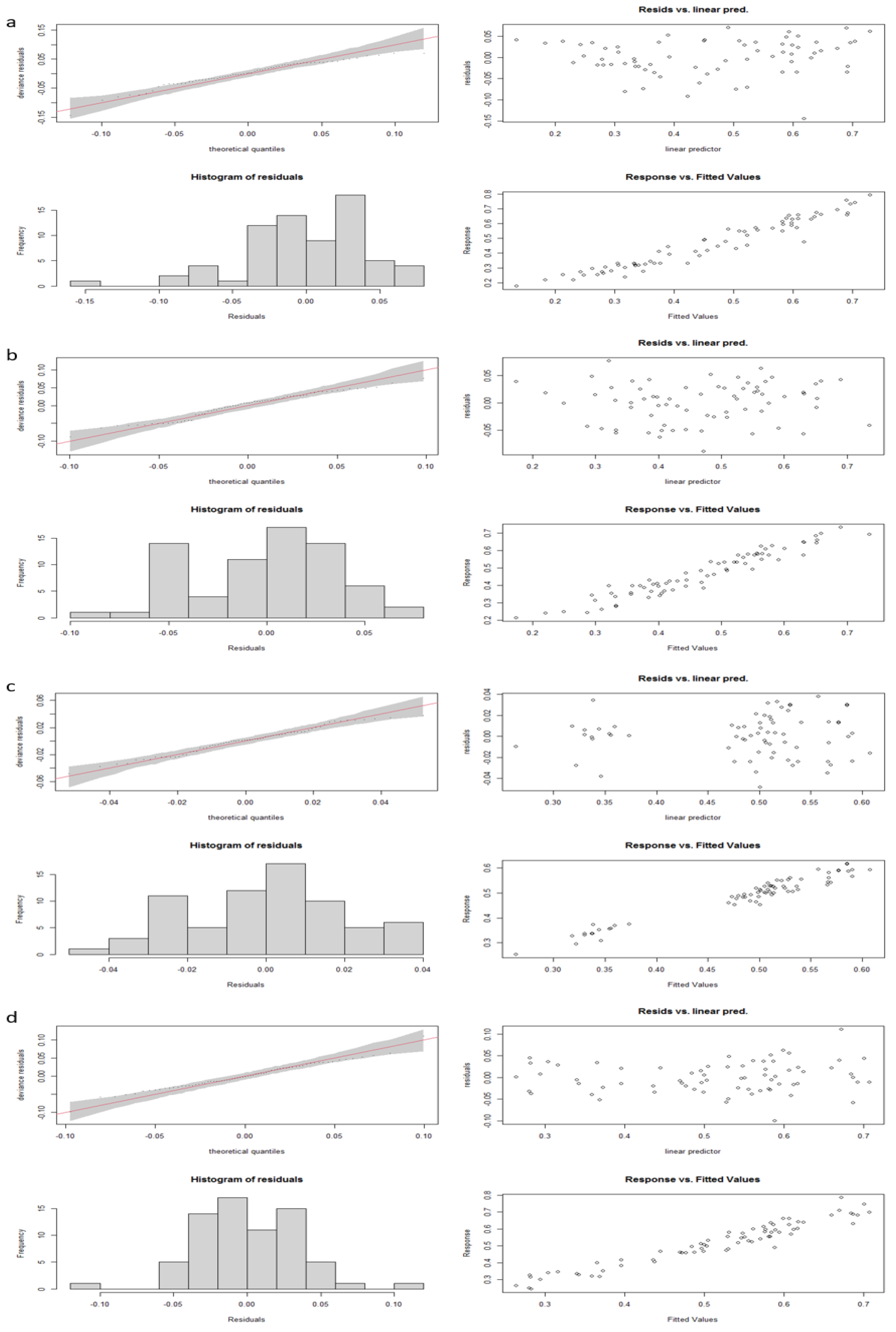
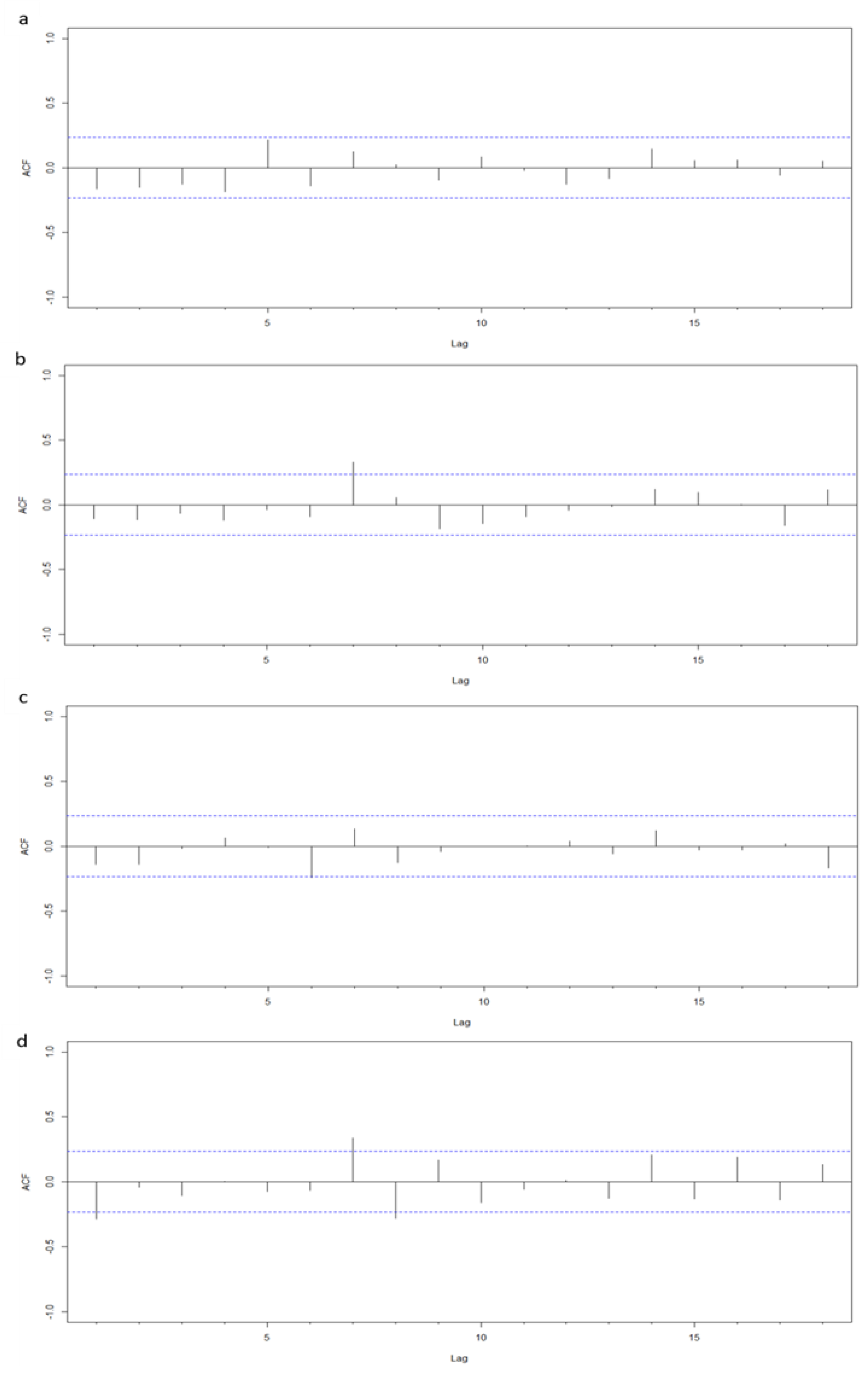

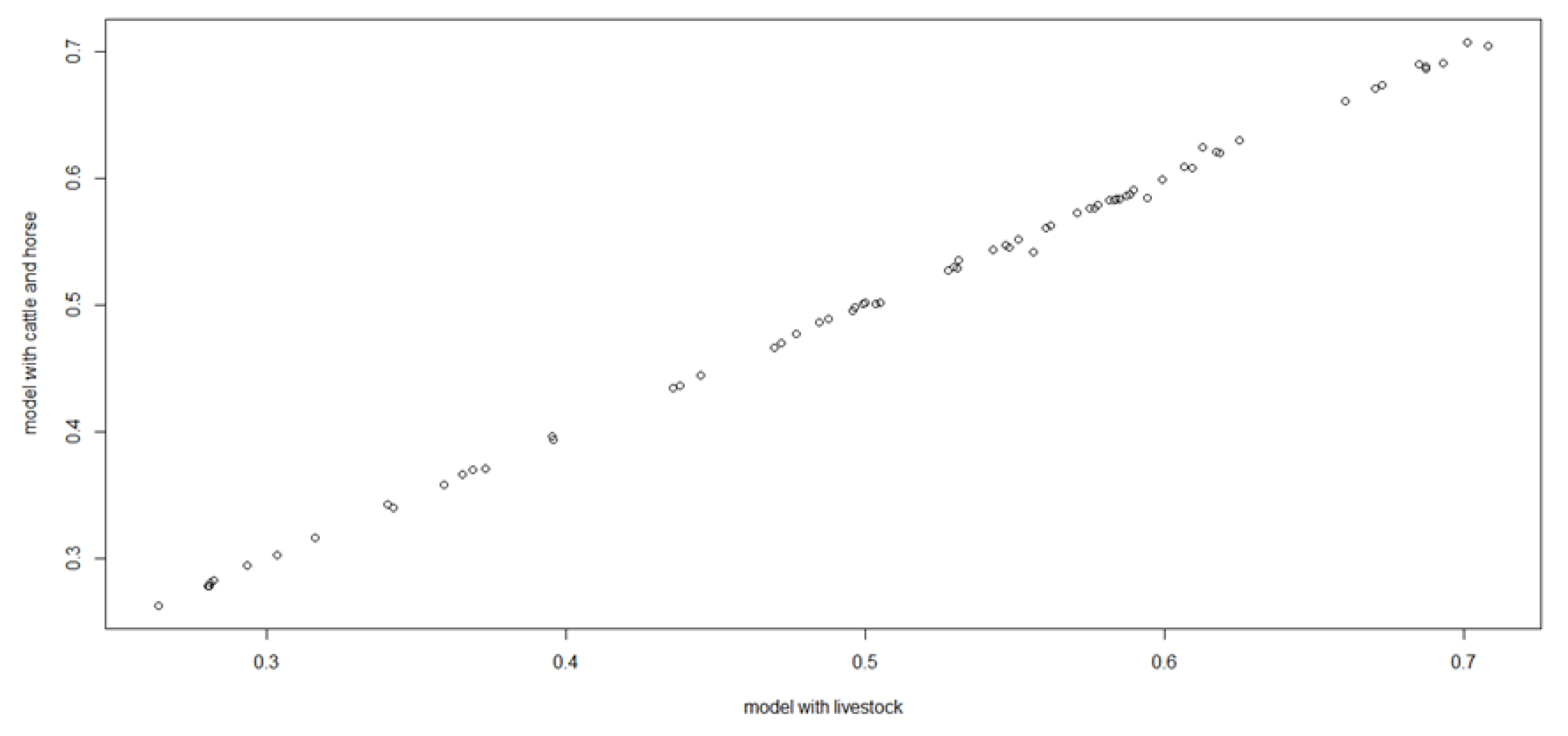

| Saltmarsh | Bulrush Marsh | Shrubland | Grassland | |
|---|---|---|---|---|
| Rainfall | F(2.38,4) = 6.86 p < 5.35 × 10−7 | F(2.76,4) = 12.5 p < 2 × 10−16 | F(2.61,4) = 12.18 p < 0.0025 | F(2.79,4) = 10.54 p < 7.56 × 10−7 |
| Phenology | F(1.7,4) = 10.29 p < 0.00018 | F(6.69 × 10−1,4) = 0.78 p > 0.0522 | F(2.16,4) = 117.7 p < 0.00012 | F(8.81 × 10−1,4) = 6.43 p < 0.0015 |
| Rainfall*Phenology | F(4.4 × 10−5,16) < 0.01 p > 0.467 | F(1.09,16) = 0.99 p < 0.011 | F(6.19 × 10−5,16) < 0.01 p > 0.79 | F(5.88,16) = 1.25 p < 0.0442 |
| Horse | F(1.12,4) = 2.44 p > 0.322 | F(9.04 × 10−1,4) = 46.6 p < 0.0017 | F(1.53 × 10−5,4) < 0.01 p > 0.78 | F(3.94 × 10−1,4) = 0.98 p > 0.19 |
| Cattle | F(2.4 × 10−5,4) < 0.01 p > 0.886 | F(9.2 × 10−1,4) = 34.18 p < 0.00041 | F(3.97 × 10−5,4) < 0.01 p > 0.50 | F(8.9 × 10−6,4) < 0.01 p > 0.89 |
| Fallow deer | F(1.0 × 10−1,4) = 0.032 p > 0.267 | F(6.4 × 10−5,4) < 0.01 p > 0.39 | F(9.52 × 10−5,4) < 0.01 p > 0.35 | F(4.07 × 10−5,4) < 0.01 p > 0.45 |
| Red deer | F(8.07 × 10−1,4) = 8.81 p < 0.021 | F(9.4 × 10−5,4) < 0.01 p > 0.56 | F(7.18 × 10−5,4) < 0.01 p > 0.59 | F(4.56 × 10−5,4) < 0.01 p > 0.40 |
| Space (manag.unit) | F(3.91,4) = 54.7 p < 2 × 10−16 | F(3.96,4) = 132.5 p < 2 × 10−16 | F(3.98,4) = 188.3 p < 2 × 10−16 | F(3.94,4) = 55.25 p < 2 × 10−16 |
| Time (year) | F(6.18,12) = 2.29 p < 0.0005 | F(7.87,12) = 3.69 p < 2.34 × 10−5 | F(2.2 × 10−5,12) < 0.01 p > 0.83 | F(9.26 × 10−6,12) < 0.01 p > 0.55 |
| Adjusted R2 | 0.90 | 0.93 | 0.94 | 0.89 |
| Deviance explained (%) | 92.5 | 95.2 | 94.8 | 91.8 |
References
- von Keyserlingk, J.; de Hoop, M.; Mayor, A.G.; Dekker, S.C.; Rietkerk, M.; Förster, S. Resilience of vegetation to drought: Studying the effect of grazing in a Mediterranean rangeland using satellite time series. Remote Sens. Environ. 2021, 255, 112270. [Google Scholar] [CrossRef]
- Cho, M.A.; Skidmore, A.; Corsi, F.; van Wieren, S.E.; Sobhan, I. Estimation of green grass/herb biomass from airborne hyperspectral imagery using spectral indices and partial least squares regression. Int. J. Appl. Earth Obs. Geoinf. 2007, 9, 414–424. [Google Scholar] [CrossRef]
- Carmona, C.P.; Röder, A.; Azcárate, F.M.; Peco, B. Grazing management or physiography? Factors controlling vegetation recovery in Mediterranean grasslands. Ecol. Model. 2013, 251, 73–84. [Google Scholar] [CrossRef]
- Mayor, A.G.; Kéfi, S.; Bautista, S.; Rodríguez, F.; Cartení, F.; Rietkerk, M. Feedbacks between vegetation pattern and resource loss dramatically decrease ecosystem resilience and restoration potential in a simple dryland model. Landsc. Ecol. 2013, 28, 931–942. [Google Scholar] [CrossRef]
- Zhou, Z.C.; Gan, Z.T.; Shangguan, Z.P.; Dong, Z.B. Effects of grazing on soil physical properties and soil erodibility in semiarid grassland of the Northern Loess Plateau (China). Catena 2010, 82, 87–91. [Google Scholar] [CrossRef]
- Robles, A.B.; Ruiz-Mirazo, J.; Ramos, M.E.; González-Rebollar, J.L. Role of Grazing Livestock in Sustainable Use, Fire Prevention and Naturalization of Marginal Ecosystems of Southeastern Spain. Agroforestry in Europe. Current Status and Future Prospects; Springer: Dordrecht, The Netherlands, 2009; pp. 211–231. [Google Scholar]
- Agrawal, A.A.; Fishbein, M. Plant defense syndromes. Ecology 2006, 87, S132–S149. [Google Scholar] [CrossRef]
- Manzano, P.; Malo, J.E.; Peco, B. Sheep gut passage and survival of Mediterranean shrub seeds. Seed Sci. Res. 2005, 15, 21. [Google Scholar] [CrossRef] [Green Version]
- Albert, A.; Auffret, A.G.; Cosyns, E.; Cousins, S.A.; D’hondt, B.; Eichberg, C.; Baltzinger, C. Seed dispersal by ungulates as an ecological filter: A trait-based meta-analysis. Oikos 2015, 124, 1109–1120. [Google Scholar] [CrossRef]
- Hobbs, N.T. Modification of ecosystems by ungulates. J. Wildl. Manag. 1996, 60, 695–713. [Google Scholar] [CrossRef]
- Mysterud, A. The concept of overgrazing and its role in management of large herbivores. Wildl. Biol. 2006, 12, 129–141. [Google Scholar] [CrossRef] [Green Version]
- Ruppert, J.C.; Harmoney, K.; Henkin, Z.; Snyman, H.A.; Sternberg, M.; Willms, W.; Linstädter, A. Quantifying drylands’ drought resistance and recovery: The importance of drought intensity, dominant life history and grazing regime. Glob. Chang. Biol. 2015, 21, 1258–1270. [Google Scholar] [CrossRef]
- Kawamura, K.; Akiyama, T.; Yokota, H.O.; Tsutsumi, M.; Yasuda, T.; Watanabe, O.; Wang, S. Quantifying grazing intensities using geographic information systems and satellite remote sensing in the Xilingol steppe region, Inner Mongolia, China. Agric. Ecosyst. Environ. 2005, 107, 83–93. [Google Scholar] [CrossRef]
- Zamora, R.; Gómez, J.M.; Hódar, J.A.; Castro, J.; García, D. Effect of browsing by ungulates on sapling growth of Scots pine in a Mediterranean environment: Consequences for forest regeneration. For. Ecol. Manag. 2001, 144, 33–42. [Google Scholar] [CrossRef]
- Plieninger, T.; Wilbrand, C. Land use, biodiversity conservation, and rural development in the dehesas of Cuatro Lugares, Spain. Agrofor. Syst. 2001, 51, 23–34. [Google Scholar] [CrossRef]
- Côté, S.D.; Rooney, T.P.; Tremblay, J.P.; Dussault, C.; Waller, D.M. Ecological impacts of deer overabundance. Annu. Rev. Ecol. Evol. Syst. 2004, 35, 113–147. [Google Scholar] [CrossRef] [Green Version]
- Carpio, A.J.; Apollonio, M.; Acevedo, P. Wild ungulate overabundance in Europe: Contexts, causes, monitoring and management recommendations. Mammal Rev. 2021, 51, 95–108. [Google Scholar] [CrossRef]
- Hegland, S.J.; Rydgren, K.; Seldal, T. The response of Vaccinium myrtillus to variations in grazing intensity in a Scandinavian pine forest on the island of Svanøy. Botany 2005, 83, 1638–1644. [Google Scholar] [CrossRef]
- Manier, D.J.; Hobbs, N.T. Large herbivores in sagebrush steppe ecosystems: Livestock and wild ungulates influence structure and function. Oecologia 2007, 152, 739–750. [Google Scholar] [CrossRef]
- Beschta, R.L.; Donahue, D.L.; DellaSala, D.A.; Rhodes, J.J.; Karr, J.R.; O’Brien, M.H.; Williams, C.D. Adapting to climate change on western public lands: Addressing the ecological effects of domestic, wild, and feral ungulates. Environ. Manag. 2013, 51, 474–491. [Google Scholar] [CrossRef] [PubMed]
- Archibald, S.; Bond, W.J.; Stock, W.D.; Fairbanks, D.H.K. Shaping the landscape: Fire–grazer interactions in an African savanna. Ecol. Appl. 2005, 15, 96–109. [Google Scholar] [CrossRef]
- Lazaro, R.; Rodrigo, F.S.; Gutiérrez, L.; Domingo, F.; Puigdefábregas, J. Analysis of a 30-year rainfall record (1967–1997) in semi–arid SE Spain for implications on vegetation. J. Arid Environ. 2001, 48, 373–395. [Google Scholar] [CrossRef]
- López-Sánchez, A.; Perea, R.; Dirzo, R.; Roig, S. Livestock vs. wild ungulate management in the conservation of Mediterranean dehesas: Implications for oak regeneration. For. Ecol. Manag. 2016, 362, 99–106. [Google Scholar] [CrossRef]
- Velamazan, M.; Perea, R.; Bugalho, M.N. Ungulates and ecosystem services in Mediterranean woody systems: A semi-quantitative review. J. Nat. Conserv. 2020, 55, 125837. [Google Scholar] [CrossRef]
- Naveh, Z. The dependence of the productivity of a semi-arid Mediterranean hill pasture ecosystem on climatic fluctuations. Agric. Environ. 1982, 7, 47–61. [Google Scholar] [CrossRef]
- Odadi, W.O.; Karachi, M.K.; Abdulrazak, S.A.; Young, T.P. African wild ungulates compete with or facilitate cattle depending on season. Science 2011, 333, 1753–1755. [Google Scholar] [CrossRef] [PubMed] [Green Version]
- Fuhlendorf, S.D.; Fynn, R.W.; McGranahan, D.A.; Twidwell, D. Heterogeneity as the Basis for Rangeland Management. In Rangeland Systems; Springer: Cham, Switzerland, 2017; pp. 169–196. [Google Scholar] [CrossRef]
- Milner, J.M.; Van Beest, F.M.; Schmidt, K.T.; Brook, R.K.; Storaas, T. To feed or not to feed? Evidence of the intended and unintended effects of feeding wild ungulates. J. Wildl. Manag. 2014, 78, 1322–1334. [Google Scholar] [CrossRef] [Green Version]
- Vetter, S. Rangelands at equilibrium and non-equilibrium: Recent developments in the debate. J. Arid Environ. 2005, 62, 321–341. [Google Scholar] [CrossRef]
- Caballero, R.; Fernandez-Gonzalez, F.; Badia, R.P.; Molle, G.; Roggero, P.P.; Bagella, S.; Ispikoudis, I. Grazing systems and biodiversity in Mediterranean areas: Spain, Italy and Greece. Pastos 2011, 39, 9–154. [Google Scholar]
- Graham, R.T.; Jain, T.B.; Kingery, J.L. Ameliorating conflicts among deer, elk, cattle and/or other ungulates and other forest uses: A synthesis. Forestry 2010, 83, 245–255. [Google Scholar] [CrossRef] [Green Version]
- Weisberg, P.J.; Hobbs, N.T.; Ellis, J.E.; Coughenour, M.B. An ecosystem approach to population management of ungulates. J. Environ. Manag. 2002, 65, 181–197. [Google Scholar] [CrossRef] [Green Version]
- Gómez-Baggethun, E.; Kelemen, E.; Martín-López, B.; Palomo, I.; Montes, C. Scale misfit in ecosystem service governance as a source of environmental conflict. Soc. Nat. Resour. 2013, 26, 1202–1216. [Google Scholar] [CrossRef]
- Knapp, A.K.; Beier, C.; Briske, D.D.; Classen, A.T.; Luo, Y.; Reichstein, M.; Weng, E. Consequences of more extreme precipitation regimes for terrestrial ecosystems. Bioscience 2008, 58, 811–821. [Google Scholar] [CrossRef]
- IPCC. 2014: Climate Change 2014: Impacts, Adaptation, and Vulnerability. Part B: Regional Aspects; Contribution of Working Group II to the Fifth Assessment Report of the Intergovernmental Panel on Climate Change; Barros, V.R., Field, C.B., Dokken, D.J., Mastrandrea, M.D., Mach, K.J., Bilir, T.E., Chatterjee, M., Ebi, K.L., Estrada, Y.O., Genova, R.C., et al., Eds.; Cambridge University Press: Cambridge, UK; New York, NY, USA, 2014; p. 688. ISBN 978-1-107-05816-3. [Google Scholar]
- Turner, W. Sensing biodiversity. Science 2014, 346, 301–302. [Google Scholar] [CrossRef]
- Zhang, X.; Friedl, M.A.; Schaaf, C.B.; Strahler, A.H.; Hodges, J.C.; Gao, F.; Huete, A. Monitoring vegetation phenology using MODIS. Remote Sens. Environ. 2003, 84, 471–475. [Google Scholar] [CrossRef]
- Turner, W.; Spector, S.; Gardiner, N.; Fladeland, M.; Sterling, E.; Steininger, M. Remote sensing for biodiversity science and conservation. Trends Ecol. Evol. 2003, 18, 306–314. [Google Scholar] [CrossRef]
- Vihervaara, P.; Auvinen, A.P.; Mononen, L.; Törmä, M.; Ahlroth, P.; Anttila, S.; Virkkala, R. How essential biodiversity variables and remote sensing can help national biodiversity monitoring. Glob. Ecol. Conserv. 2017, 10, 43–59. [Google Scholar] [CrossRef]
- Lausch, A.; Bastian, O.; Klotz, S.; Leitão, P.J.; Jung, A.; Rocchini, D.; Knapp, S. Understanding and assessing vegetation health by in situ species and remote-sensing approaches. Methods Ecol. Evol. 2018, 9, 1799–1809. [Google Scholar] [CrossRef]
- Andreu, A.; Bravo, M.A.; Ceballos, O.; Chans, J.J.; Díaz-Delgado, R.; Máñez, M. Monitoring Protocols for the Long-Term Scientific Monitoring of Natural Resources and Processes; ICTS—Reserva Biológica de Doñana, Estación Biológica de Doñana-CSIC: Sevilla, Spain, 2014; p. 313. Available online: http://icts.ebd.csic.es/document-repository-donana (accessed on 5 May 2019).
- ESRI. ArcGIS Desktop: Release 10; Environmental Systems Research Institute: Redlands, CA, USA, 2011. [Google Scholar]
- Vuolo, F.; Mattiuzzi, M.; Klisch, A.; Atzberger, C. Data Service Platform for MODIS NDVI Time Series Pre-Processing at BOKU Vienna: Current Status and Future Perspectives. In Proceedings of the SPIE—Earth Resources and Environmental Remote Sensing/GIS Applications III, Edinburgh, UK, 25‒27 September 2012; Volume 8538. Paper 85380A. [Google Scholar] [CrossRef]
- Gaitán, J.J.; Bran, D.; Oliva, G.; Ciari, G.; Nakamatsu, V.; Salomone, J.; Maestre, F.T. Evaluating the performance of multiple remote sensing indices to predict the spatial variability of ecosystem structure and functioning in Patagonian steppes. Ecol. Indic. 2013, 34, 181–191. [Google Scholar] [CrossRef]
- Helman, D.; Mussery, A.; Lensky, I.M.; Leu, S. Detecting changes in biomass productivity in a different land management regime in drylands using satellite-derived vegetation index. Soil Use Manag. 2014, 30, 32–39. [Google Scholar] [CrossRef]
- Vicente-Serrano, S.M.; Gouveia, C.; Camarero, J.J.; Beguería, S.; Trigo, R.; López-Moreno, J.I.; Sanchez-Lorenzo, A. Response ofvegetation to drought time-scales across global land biomes. Proc. Natl. Acad. Sci. USA 2013, 110, 52–57. [Google Scholar] [CrossRef] [PubMed] [Green Version]
- Lumbierres, M.; Méndez, P.F.; Bustamante, J.; Soriguer, R.; Santamaría, L. Modeling biomass production in seasonal wetlands using MODIS NDVI land surface phenology. Remote Sens. 2017, 9, 392. [Google Scholar] [CrossRef] [Green Version]
- Jonsson, P.; Eklundh, L. TIMESAT—A program for analyzing time-series of satellite sensor data. Comput. Geosci. 2004, 30, 833–845. [Google Scholar] [CrossRef] [Green Version]
- Wood, S.N. Fast stable restricted maximum likelihood and marginal likelihood estimation of semiparametric generalized linear models. J. R. Stat. Soc. Ser. B 2011, 73, 3–36. [Google Scholar] [CrossRef] [Green Version]
- Wood, S.N.; Pya, N.; Säfken, B. Smoothing parameter and model selection for general smooth models. J. Am. Stat. Assoc. 2016, 111, 1548–1563. [Google Scholar] [CrossRef]
- Hyndman, R.J.; Khandakar, Y. Automatic Time Series for Forecasting: The Forecast Package for R (No. 6/07); Monash University, Department of Econometrics and Business Statistics: Clayton, Australia, 2007. [Google Scholar]
- Hyndman, R.J.; Athanasopoulos, G.; Bergmeir, C.; Caceres, G.; Chhay, L.; O’Hara-Wild, M.; Wang, E. Package ‘Forecast’. 2020. Available online: https://cran.r-project.org/web/packages/forecast/forecast.pdf (accessed on 15 September 2020).
- REDIAM. Aplicación de Descarga y Visualización de Escenarios Climáticos Regionalizados para Andalucía. Manual de la Aplicación (v. 1.0). 2014. Available online: https://kerdoc.cica.es/cc/about/Manual_aplicacion.pdf (accessed on 20 October 2020).
- Errasti, I.; Ezcurra, A.; Sáenz, J.; Ibarra-Berastegi, G. Validation of IPCC AR4 models over the Iberian Peninsula. Theor. Appl. Climatol. 2011, 103, 61–79. [Google Scholar] [CrossRef]
- Nieto, S.; Rodríguez-Puebla, C. Comparison of precipitation from observed data and general circulation models over the Iberian Peninsula. J. Clim. 2006, 19, 4254–4275. [Google Scholar] [CrossRef]
- Van Vuuren, D.P.; Edmonds, J.; Kainuma, M.; Riahi, K.; Thomson, A.; Hibbard, K.; Rose, S.K. The representative concentration pathways: An overview. Clim. Chang. 2011, 109, 5–31. [Google Scholar] [CrossRef]
- Provenza, F.D.; Villalba, J.J.; Dziba, L.E.; Atwood, S.B.; Banner, R.E. Linking herbivore experience, varied diets, and plant biochemical diversity. Small Rumin. Res. 2003, 49, 257–274. [Google Scholar] [CrossRef]
- Fuhlendorf, S.D.; Engle, D.M.; Elmore, R.D.; Limb, R.F.; Bidwell, T.G. Conservation of pattern and process: Developing an alternative paradigm of rangeland management. Rangel. Ecol. Manag. 2012, 65, 579–589. [Google Scholar] [CrossRef] [Green Version]
- Schneider, F.D.; Kéfi, S. Spatially heterogeneous pressure raises risk of catastrophic shifts. Theor. Ecol. 2016, 9, 207–217. [Google Scholar] [CrossRef] [Green Version]
- Stewart, K.M.; Bowyer, R.T.; Kie, J.G.; Dick, B.L.; Ruess, R.W. Population density of North American elk: Effects on plant diversity. Oecologia 2009, 161, 303–312. [Google Scholar] [CrossRef] [PubMed]
- Gill, R.M.A.; Beardall, V. The impact of deer on woodlands: The effects of browsing and seed dispersal on vegetation structure and composition. For. Int. J. For. Res. 2001, 74, 209–218. [Google Scholar] [CrossRef] [Green Version]
- Xu, X.; Riley, W.J.; Koven, C.D.; Jia, G. Heterogeneous spring phenology shifts affected by climate: Supportive evidence from two remotely sensed vegetation indices. Environ. Res. Commun. 2019, 1, 091004. [Google Scholar] [CrossRef] [Green Version]
- Root, T.L.; Price, J.T.; Hall, K.R.; Schneider, S.H.; Rosenzweig, C.; Pounds, J.A. Fingerprints of global warming on wild animals and plants. Nature 2003, 421, 57–60. [Google Scholar] [CrossRef]
- Menzel, A.; Sparks, T.H.; Estrella, N.; Koch, E.; Aasa, A.; Ahas, R.; Zust, A.N.A. European phenological response to climate change matches the warming pattern. Glob. Chang. Biol. 2006, 12, 1969–1976. [Google Scholar] [CrossRef]
- Sloat, L.L.; Gerber, J.S.; Samberg, L.H.; Smith, W.K.; Herrero, M.; Ferreira, L.G.; West, P.C. Increasing importance of precipitation variability on global livestock grazing lands. Nat. Clim. Chang. 2018, 8, 214–218. [Google Scholar] [CrossRef]
- Allred, B.W.; Scasta, J.D.; Hovick, T.J.; Fuhlendorf, S.D.; Hamilton, R.G. Spatial heterogeneity stabilizes livestock productivity in a changing climate. Agric. Ecosyst. Environ. 2014, 193, 37–41. [Google Scholar] [CrossRef]
- Sneva, F.A.; Hyder, D.N. Estimating herbage production on semiarid ranges in the Intermountain Region. Rangel. Ecol. Manag. J. Range Manag. Arch. 1962, 15, 88–93. [Google Scholar] [CrossRef]
- Le Houérou, H.N. Grassland of Africa: Classification, Production Evolution and Development Outlook. In Proceedings of the XIII International Grassland Congress, Leipzig, Germany, 18–27 May 1977; Wojahn, E., Thons, H., Eds.; Akademie-Verlag: Berlin, Germany, 1980. [Google Scholar]
- van de Koppel, J.; Rietkerk, M.; Weissing, F.J. Catastrophic vegetation shifts and soil degradation in terrestrial grazing systems. Trends Ecol. Evol. 1997, 12, 352–356. [Google Scholar] [CrossRef] [Green Version]
- Lohmann, D.; Tietjen, B.; Blaum, N.; Joubert, D.F.; Jeltsch, F. Shifting thresholds and changing degradation patterns: Climate change effects on the simulated long-term response of a semi-arid savanna to grazing. J. Appl. Ecol. 2012, 49, 814–823. [Google Scholar] [CrossRef]
- Booth, D.T.; Tueller, P.T. Rangeland monitoring using remote sensing. Arid Land Res. Manag. 2003, 17, 455–467. [Google Scholar] [CrossRef]
- Hunt, E.R., Jr.; Everitt, J.H.; Ritchie, J.C.; Moran, M.S.; Booth, D.T.; Anderson, G.L.; Seyfried, M.S. Applications and research using remote sensing for rangeland management. Photogramm. Eng. Remote Sens. 2003, 69, 675–693. [Google Scholar] [CrossRef] [Green Version]
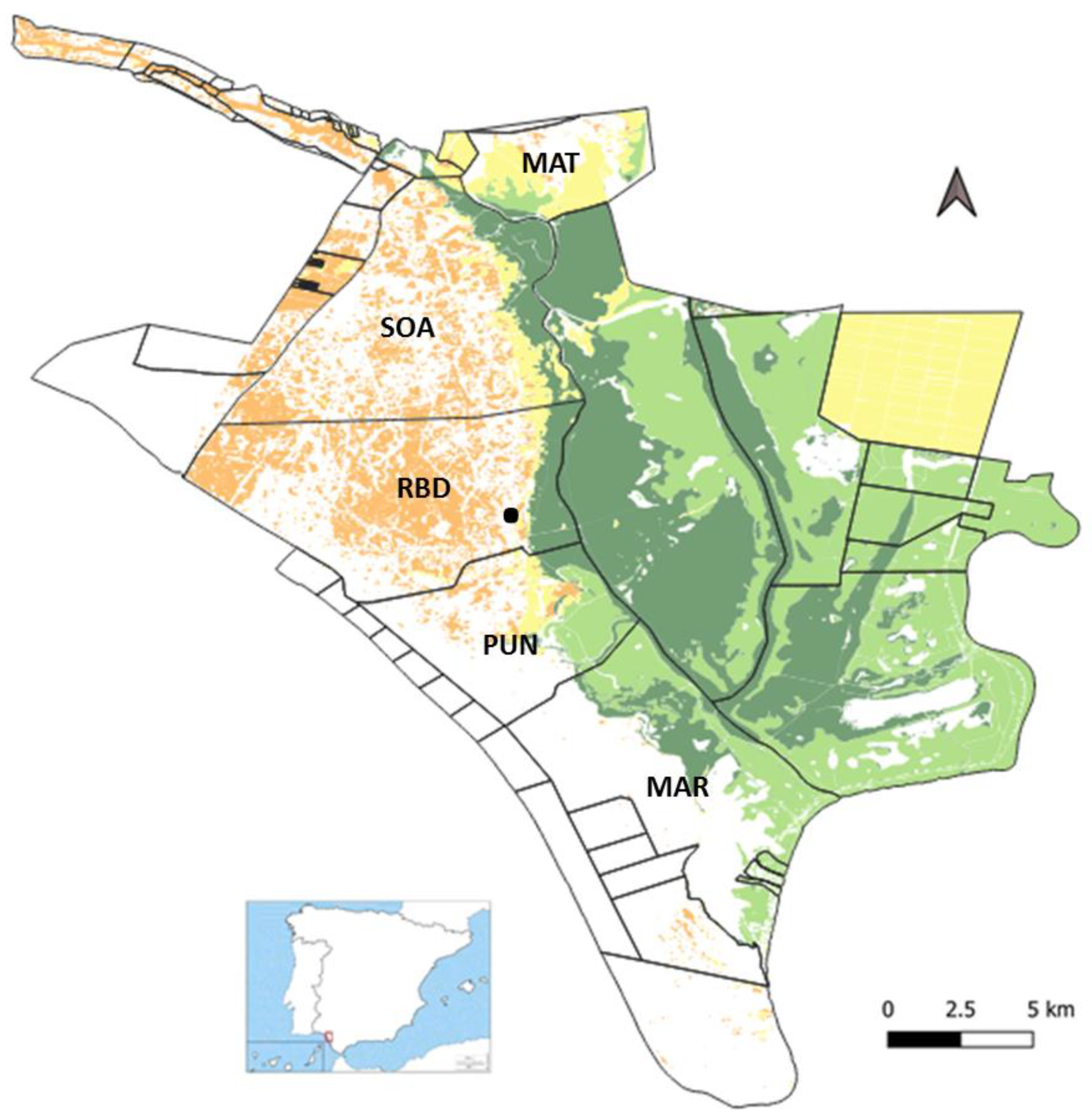

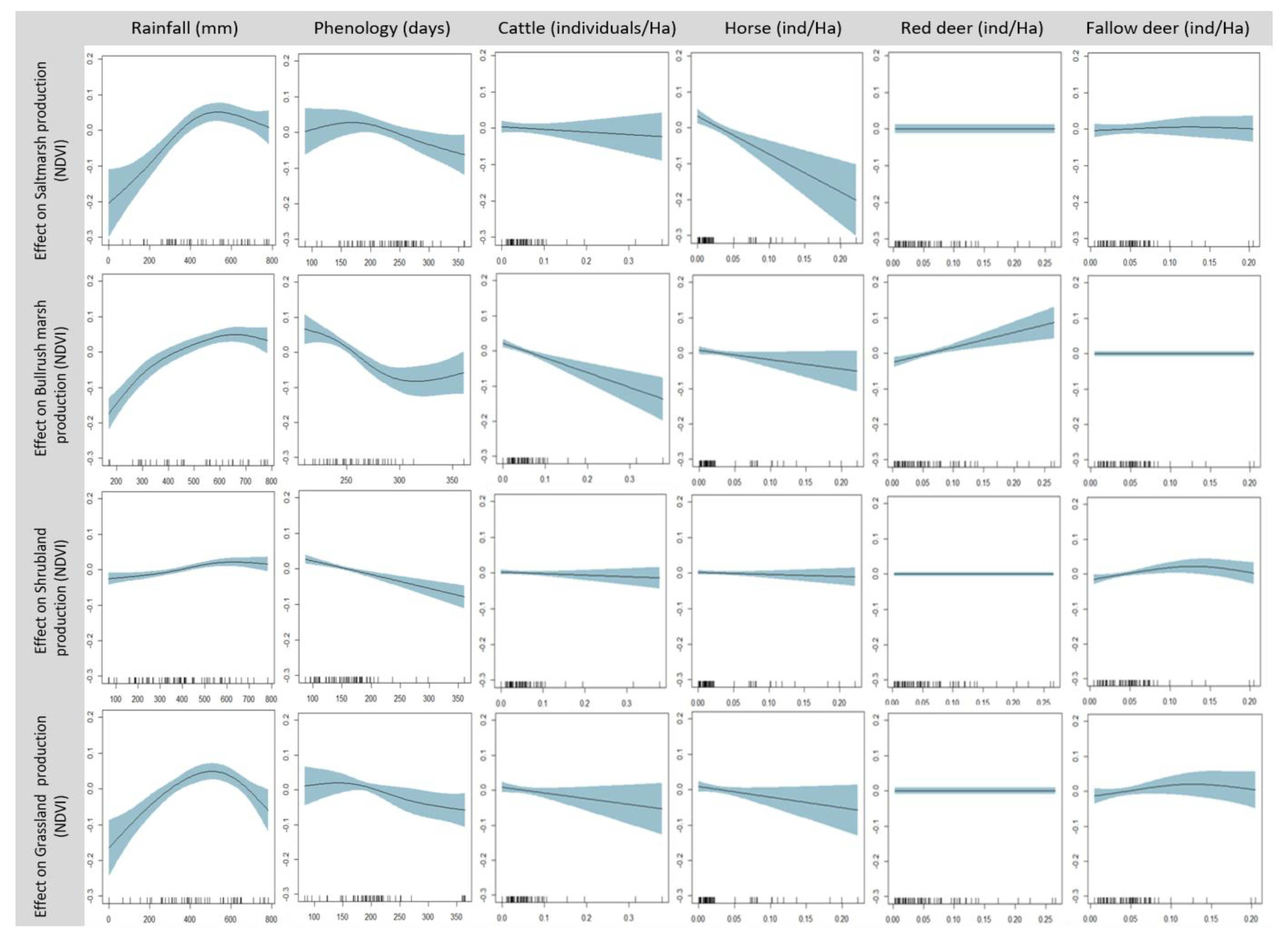
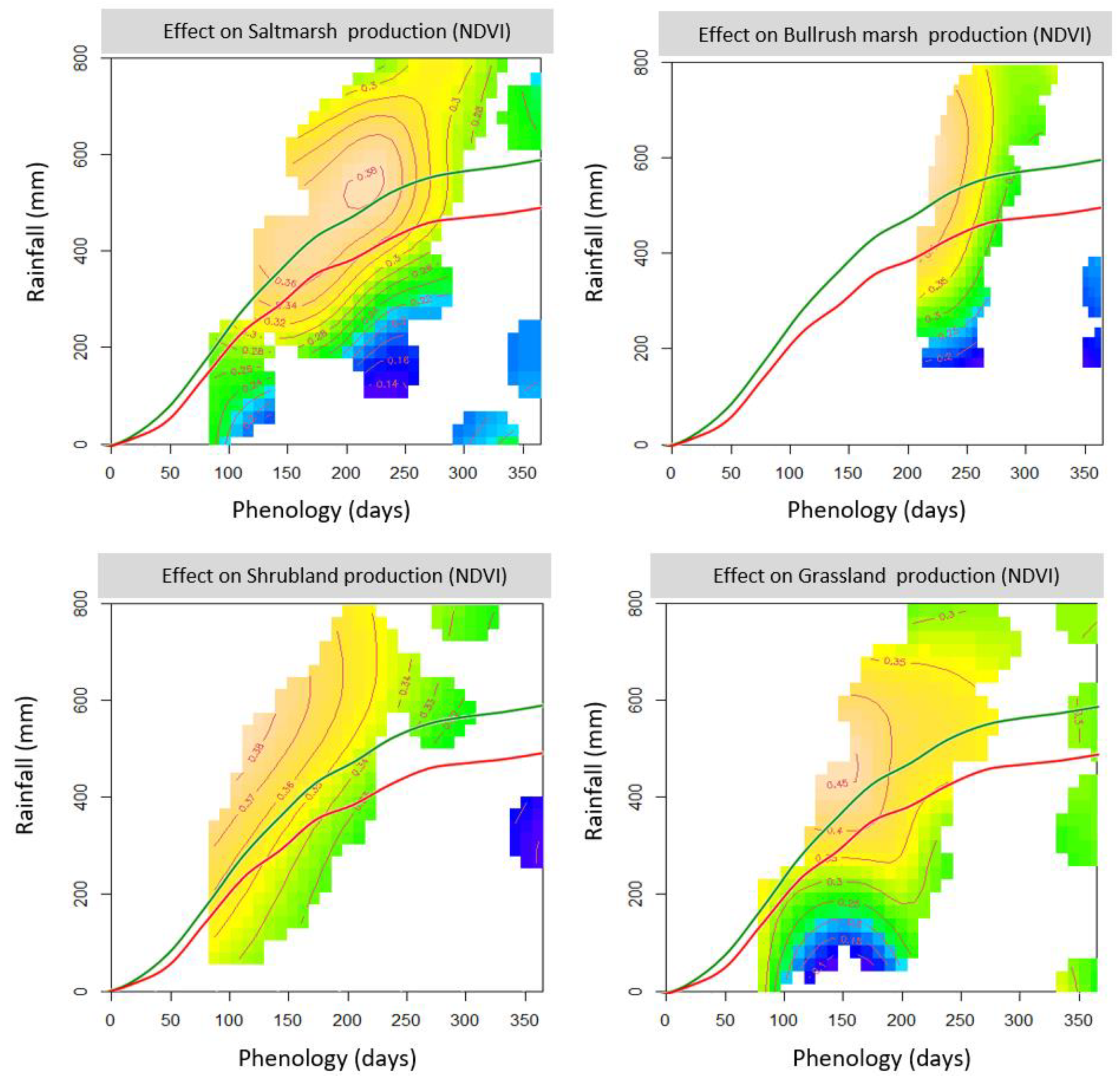

| Vegetation Type | Description |
|---|---|
| Saltmarsh | Halophilous scrub (‘almajar’) on floodplain/marine brackish mudflats, dominated by glaucous glasswort (Arthrocnemun acrosticism) and shrubby sea-blite (Suaeda vera), interspersed with halophilous grass meadows. |
| Bulrush marsh | Seasonal meadows of tall sedges (Fam. Cyperaceae) on floodplain/brackish marshes. Dominant species are saltmarsh bulrush (Bolboschoenus maritimus), Blysmus bulrush (Schoenoplectus litoralis) and somerset rush (Juncus subulatus), which may be dominant or co-dominant. |
| Shrubland | Shrub formations on stabilized dunes, sometimes interspersed with sandy grasslands. These formations include a mosaic of two main types, respectively occupying more xeric and mesic sites: dry scrubland (‘monte blanco), dominated by Halimium halimifolium, Cistus silvicolous, C. libanotis, Rosmarinus officinalis, and Lavandula stoechas; and wet shrubland (‘monte negro’), dominated by heather (Erica scoparia, E. umbellata, E. ciliaris, Calluna vulgaris), Rubus ulmifolius, Ulex minor and Ulex australis. |
| Grassland | Wet pasture formations usually spatially associated with lagoons and in the ecotone that forms the marsh and inland areas, usually called “la vera”. Dominated by the association of Galium palustre with Juncus maritimus. |
| Time of ungulate census | Saltmarsh | Bulrush marsh | Shrubland | Grassland | ||||
|---|---|---|---|---|---|---|---|---|
| AIC | R2 | AIC | R2 | AIC | R2 | AIC | R2 | |
| Start of growth season | −195.5 | 0.91 | −231.1 | 0.90 | −325.1 | 0.94 | −228.5 | 0.90 |
| End of growth season | −193.6 | 0.90 | −256.7 | 0.93 | −331.7 | 0.94 | −227.1 | 0.89 |
| Saltmarsh | Bulrush Marsh | Shrubland | Grassland | |
|---|---|---|---|---|
| Rainfall | F(2.17,4) = 6.32 p < 1.6 × 10−6 | F(3.09,4) = 19.9 p < 2 × 10−16 | F(1.99,4) = 5.91 p < 4.2 × 10−5 | F(2.27,4) = 6.03 p < 3.26 × 10−6 |
| Phenology | F(1.5,4) = 2.29 p < 0.0042 | F(2.16,4) = 9.59 p < 8.3 × 10−7 | F(1.02,4) = 53.89 p < 1.7 × 10−6 | F(1.45,4) = 6.69 p < 0.0074 |
| Rainfall*Phenology | F(5.29,16) = 1.33 p < 0.0021 | F(1.26,16) = 0.37 p < 0.019 | F(0.66,16) = 0.09 p > 0.12 | F(7.28,16) = 2.54 p < 8.51 × 10−5 |
| Horse | F(1.37,4) = 18.2 p < 0.0006 | F(1.45,4) = 10.6 p > 0.0835 | F(0.40,4) = 3.17 p > 0.16 | F(0.72,4) = 5.94 p < 0.043 |
| Cattle | F(0.43,4) = 0.328 p > 0.14 | F(0.97,4) = 21.4 p < 2 × 10−16 | F(0.46,4) = 0.60 p > 0.10 | F(0.68,4) = 1.89 p < 0.027 |
| Fallow deer | F(0.35,4) = 0.33 p > 0.24 | F(1.5 × 10−6,4) < 0.01 p > 0.92 | F(1.61,4) = 30.79 p < 0.0145 | F(0.99,4) = 1.82 p > 0.067 |
| Red deer | F(1.9 × 10−5,4) < 0.01 p > 0.71 | F(1.24,4) = 30.18 p < 0.0016 | F(7.40 × 10−5,4) < 0.01 p > 0.54 | F(3.92 × 10−5,4) < 0.01 p > 0.70 |
| Space (manag.unit) | F(3.94,4) = 87.2 p < 2 × 10−16 | F(3.83,4) = 35.2 p < 2 × 10−16 | F(3.97,4) = 160.91 p < 2 × 10−16 | F(3.92,4) = 44.96 p < 2 × 10−16 |
| Time (year) | F(4.82,12) = 1.73 p < 0.00094 | F(2.8 × 10−6,12) < 0.01 p > 0.52 | F(1.5 × 10−5,12) < 0.01 p > 0.80 | F(9.9 × 10−6,12) < 0.01 p > 0.83 |
| Adjusted R2 | 0.91 | 0.90 | 0.94 | 0.90 |
| Deviance explained (%) | 93.5 | 92.2 | 94.8 | 92.9 |
Publisher’s Note: MDPI stays neutral with regard to jurisdictional claims in published maps and institutional affiliations. |
© 2021 by the authors. Licensee MDPI, Basel, Switzerland. This article is an open access article distributed under the terms and conditions of the Creative Commons Attribution (CC BY) license (https://creativecommons.org/licenses/by/4.0/).
Share and Cite
Giralt-Rueda, J.M.; Santamaria, L. Complementary Differences in Primary Production and Phenology among Vegetation Types Increase Ecosystem Resilience to Climate Change and Grazing Pressure in an Iconic Mediterranean Ecosystem. Remote Sens. 2021, 13, 3920. https://doi.org/10.3390/rs13193920
Giralt-Rueda JM, Santamaria L. Complementary Differences in Primary Production and Phenology among Vegetation Types Increase Ecosystem Resilience to Climate Change and Grazing Pressure in an Iconic Mediterranean Ecosystem. Remote Sensing. 2021; 13(19):3920. https://doi.org/10.3390/rs13193920
Chicago/Turabian StyleGiralt-Rueda, Juan Miguel, and Luis Santamaria. 2021. "Complementary Differences in Primary Production and Phenology among Vegetation Types Increase Ecosystem Resilience to Climate Change and Grazing Pressure in an Iconic Mediterranean Ecosystem" Remote Sensing 13, no. 19: 3920. https://doi.org/10.3390/rs13193920
APA StyleGiralt-Rueda, J. M., & Santamaria, L. (2021). Complementary Differences in Primary Production and Phenology among Vegetation Types Increase Ecosystem Resilience to Climate Change and Grazing Pressure in an Iconic Mediterranean Ecosystem. Remote Sensing, 13(19), 3920. https://doi.org/10.3390/rs13193920






